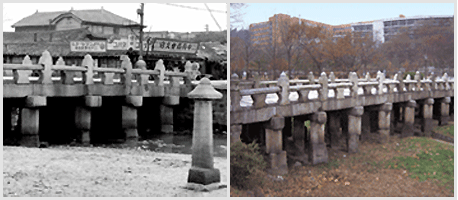|
|
 Supyogyo (Bridge) Supyogyo (Bridge)
|
|
|
One of the two most widely known bridges in Seoul along with Gwangtonggyo, Supogyo (literally meaning “Water Gauge Bridge”)
was a structure of about 27.5 meters long and 8.3 meters wide when it was first built. It was built in 1420, the 2nd year of
King Sejong’s rule, and was called Majeongyo (“Horse Market Bridge”) because there was a horse market in a nearby area. The
name was changed into Supyogyo in 1441 when a water gauge was installed near the bridge that indicated the level of water
running through Cheonggyecheon. The name of the area containing the bridge was changed, too, into Supyo-dong.
The water gauge installed near the bridge was a devise for scientific measurement of water levels, and is now regarded as one
of the two greatest scientific instruments invented during the reign of King Sejong. The water gauge was installed along the
riverside of the Hangang, a representative river of Seoul, by inserting a graduated wooden pole into the hole of a stone
placed under water on the riverbed. A stone pole replaced the wooden pole in the 15th century when the dynasty was under the
rule of King Seongjong because wooden poles were easily damaged. The stone pole had degrees of cheok from 1 to 10 (“cheok”
being a unit of length corresponding to about 20 centimeters) with a circle on the third, sixth and ninth cheok to mark galsu
(“low water”), pyeongsu (“average water”) and daesu (“high water”) respectively. Water levels of the 9th cheok or higher meant
taking emergency measures to prepare for a flood.
|
|

|
Cheonggyecheon was a waterway whose bed remained dry for most of the year except for the rainy season in summer
during which even a few hours of rain could lead to overflowing because almost all the streams running from mountains in
and around the capital poured water into Cheonggyecheon. In the summer, the water level of Cheonggyecheon easily reached
the degree of 9-cheok, which is about 180 centimeters, which meant an emergency.
The Installation of the
water gauge at Supyogyo made the bridge a standard means for measuring the water level of Cheonggyecheon, and the
government established an office responsible to make regular reports to the king on the water levels of Cheonggyecheon.
Records show that the water gauge of Supyogyo was changed from wood to stone during the reign of King Seongjong, which was
repaired in 1760 when Cheonggyecheon underwent major dredging work. The stone gauge that is used today was replaced during
the reign of King Sunjo when other dredging work was conducted.
Supyogyo has a record of several
renovations. An inscription on the bridge’s corner stone shows that the bridge had underwent at least two major repairs,
one in 1827 and the other in 1886. Historians also found that the original Supyogyo had no railings and it was in the mid
1890s that the current railings were added. Officials believed that as the population increased in the capital at the turn
of the century, there would be more opportunities for accidents, so they installed railings. Along with Gwangtonggyo,
Supyogyo had been a favored venue for traditional folk games such as daribapgi (“bridge treading”) and yeonnalligi (“kite
flying”) played during seasonal festivities. The bridge also became a background for many interesting stories including one
about the romantic meeting between King Sukjong and his future queen, Jang Huibin. Located on the route linking the royal
palace in the north with the royal shrine of Yeonghuijeon in the capital’s southern district named Hundobang, the bridge
was regularly crossed by Joseon kings.
|

|
| They made a formal visit to the shrine on major seasonal festivities such as Seol
(lunar new year’s day), Hansik (spring celebration with “cold food”), Dano (summer festival held on the fifth day of
the fifth lunar month), Chuseok (harvest moon festival), Dongji (winter solstice festival) and Seotdal-geumeum (lunar
new year’s eve). For commoners from the capital, the king’s short journey across the bridge was a rare occasion to
have a peep at the “dragon face” of their ruler, and accordingly the area around the bridge became packed with crowds
on such days. Records say that It was right on the bridge that King Sukjong on his way back to the palace from the
shrine found a beautiful girl peeping at him between the half open door of a commoner’s house. The king fell in love
with her almost instantly and brought her into his palace, making her his woman with the title of Queen. |
|
|
| Supyogyo, along with its water gauge, had maintained its original shape until it was moved to Jangjungdan Park one
year after the project of covering Cheonggyecheon began in 1958. The Seoul Metropolitan Government planned to return the
bridge to it’s original location over the restored Cheonggyecheon in 2005, but had to change the plan because experts
believe the restoration could damage the bridge’s original form. Eventually the city authority decided to keep the bridge
at the current location and, instead, build a copy of the bridge at its original location. |
| |
|
|
|
|
|
|






